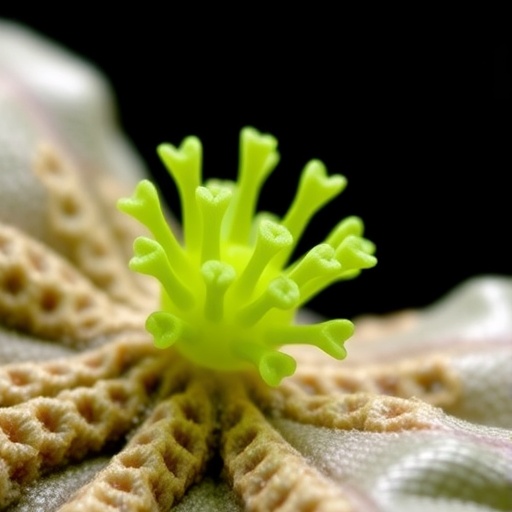In an era where the interconnections between genomic structure and evolutionary biology are garnering unprecedented attention, the recent study by Sun et al. in “BMC Genomics” sheds new light on the plastid genomes of the Saururaceae family of plants. This research not only highlights the unique characteristics of these genomes but also positions them within the broader phylogenomic landscape, offering invaluable insights into angiosperm evolution and the complex relationships among plant lineages.
The Saururaceae family, often referred to as the lizard tail family, consists of several genera predominantly found in wetland environments. These plants have evolved under specific ecological pressures, and their plastid genomes are no exception. The authors meticulously analyzed these genomes, revealing a host of variations that challenge previously held notions about the stability and uniformity often observed in plastid genome structures.
Plastid genomes are critical to plant biology, as they are the sites of photosynthesis and play a key role in energy metabolism. Unlike nuclear genomes, plastid genomes exhibit a circular structure, and their genetic materials are inherited maternally in most cases. This characteristic makes them an ideal subject for studying evolutionary relationships among plant species. In their comprehensive analysis, Sun et al. employed advanced phylogenomic techniques to elucidate the evolutionary trajectories of these plastid genomes.
One of the most striking findings of the study is the presence of distinct evolutionary markers within the plastid genomes of various Saururaceae species. These markers suggest adaptive responses to environmental changes, highlighting the resilience and evolutionary flexibility of these plants. The variation in gene content and structural rearrangements within these genomes provides a fascinating glimpse into how different species can adapt and thrive in diverse ecological niches.
Moreover, the research underscores the role of plastid genomes as molecular clocks. The authors demonstrate that variations in the rates of nucleotide substitution within these genomes can be employed to estimate divergence times among species. This finding is particularly significant for the field of phylogenomics, as it opens new avenues for understanding plant lineage diversification within the angiosperm clade.
In addition to advancing our knowledge of Saururaceae, this study also has broader implications for phylogenetic studies across various plant families. The methodologies employed by Sun et al. can be replicated in the examination of other taxa, potentially leading to a more nuanced understanding of plant evolution as a whole. This calls for a renewed focus on the plastid genome in evolutionary studies, which may have been overlooked in favor of nuclear genomes in many instances.
The study also shines a spotlight on the biotechnological potential of Saururaceae species. With an understanding of their plastid genome structure, researchers can explore genetic engineering and conservation strategies that leverage these unique characteristics. The rich secondary metabolite profiles observed in many species of Saururaceae present exciting opportunities in pharmaceutical and agricultural applications.
Furthermore, the intricacies of plastid genome evolution are not merely academic curiosities; they have real-world implications. As climate change continues to impact habitats globally, understanding the adaptability of plant species becomes crucial. Insights from studies like those of Sun et al. pave the way for conservation efforts that can ensure the survival of ecologically significant species.
In conclusion, the research presented by Sun, WH., Lv, Y., and Luo, L. not only contributes significantly to our understanding of the Saururaceae family but also revitalizes discussions surrounding plastid genome research in the context of evolutionary biology. It highlights the importance of integrating molecular, ecological, and phylogenetic data to form a comprehensive view of plant evolution. As researchers build upon these findings, the potential for groundbreaking discoveries in the field of plant sciences remains vast, beckoning a new generation of botanists and geneticists to explore the wonders of plant genomics.
This study stands as a testament to the evolving narrative of plant evolution, reminding us that the stories told by genomes are as intricate and varied as the ecosystems they inhabit. The dialogue between genetics and ecological adaptation continues to unfold, offering a landscape rich with opportunities for further exploration and discovery in the realm of plant science.
As we look forward, the pathways established by this research beckon researchers to delve deeper into the genomic intricacies of not only Saururaceae but other plant families. By unraveling the complexities of plastid genomes, we can better appreciate the diversity of life on our planet and the evolutionary processes that shape it.
Ultimately, the promise of genomics lies in its potential to enhance our understanding of biodiversity and inform conservation strategies that may mitigate the impacts of environmental change. With studies like this, we are reminded of the profound connections we have with nature and the importance of preserving the delicate balances that sustain life on Earth.
In retrospect, the work done by Sun et al. highlights the need for continued exploration and research into plant genomics. Their findings not only provide a foundational understanding of Saururaceae but also serve as an invitation to the scientific community to explore the vast, uncharted territories of plant genomes. In time, this will undoubtedly enrich our understanding of evolution and adaptation in the botanical world.
Subject of Research: Characteristics of plastid genomes in Saururaceae and their phylogenomic implications
Article Title: Characteristics of plastid genomes in the Saururaceae and their phylogenomic implications
Article References:
Sun, WH., Lv, Y., Luo, L. et al. Characteristics of plastid genomes in the Saururaceae and their phylogenomic implications.
BMC Genomics 26, 847 (2025). https://doi.org/10.1186/s12864-025-11926-x
Image Credits: AI Generated
DOI: 10.1186/s12864-025-11926-x
Keywords: plastid genome, Saururaceae, phylogenomics, angiosperm evolution, genetic adaptation, molecular biology, conservation strategies.




